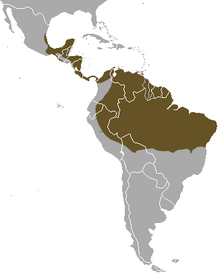Large grison
| Large grison | ||||||||||||
|---|---|---|---|---|---|---|---|---|---|---|---|---|

Large grison ( Galictis vittata ) |
||||||||||||
| Systematics | ||||||||||||
|
||||||||||||
| Scientific name | ||||||||||||
| Galictis vittata | ||||||||||||
| ( Schreber , 1776) |
The large grison ( Galictis vittata ) is a type of mammal from the marten family . It is distributed over large parts of Central and South America.
features
The large grison is significantly larger and heavier than a stone marten and slightly larger than the related small grison ( G. cuja ). It reaches a total length of about 60 to 76 centimeters and a tail length of 13.5 to 19.5 centimeters. The weight is around 1.5 to 3.8 kilograms.
The body is slim with short legs. The back is gray, the lower part of the face below the forehead, the lower part of the neck and the belly are colored black. Between these two areas, a light line runs along the head and neck down to the shoulders.
Like other martens, the large grison produces fragrances in its anal glands . The smell of these excretions is described as not as unpleasant as that of other martens. The green-yellowish secretion is only given off when extremely excited. If a large grison feels threatened, it gives a warning sound, jumps to the side, lifts the tail hair and splatters the secretion.
distribution
The large grison is mainly found in the lowlands from eastern Mexico over large parts of Central and South America to Bolivia , Argentina and Santa Catarina in Brazil . It occurs in a number of different habitats from tropical rainforests to grasslands to agricultural areas.
Way of life
The large grison is mainly diurnal, but in certain regions it can also go foraging at night. He usually rests during the warmest hours of the day. Shelters are created between crevices in the rock, in tree hollows and in the roots of the trees. Abandoned armadillos burrows are also used.
This marten is mostly on the ground and has rarely been seen on trees or bushes. Great Grisons are very good swimmers, sometimes diving for a little more than half a minute.
The large grison feeds on small mammals, birds and their eggs, lizards, amphibians and fruits. The hunt takes place either individually, in pairs or in small groups. The prey is then usually carried to special feeding places.
One to four cubs are born after a gestation of around 40 days. Births have been documented at different times of the year with the exception of winter. Many aspects of reproduction have apparently hardly been researched so far. A newborn young animal (adopted by a house cat) had closed eyes, but already had a short coat with the markings typical of adult animals. It opened its eyes after two weeks and ate meat after three weeks. After four months it was fully grown.
Grand Grisons and Humans
In its area of distribution, the large grison is often kept as a pet to fight rodents.
Existence and endangerment
The information on the population density of the species is not uniform. An estimate gave 1 to 2.4 specimens per square kilometer, according to other reports, however, the species is rare in the entire distribution area and a transmitter-equipped female had an action area of at least 4.15 square kilometers. The IUCN sees no major threats to the population and lists the species as Least Concern , even if hunting and trapping are limited.
supporting documents
- ↑ a b c d e f g h i Eric Yensen, Teresa Tarifa: Galictis vittata . In: Mammalian Species . tape 727 , 2003, p. 1–8 ( full text (PDF; 390 kB)).
- ↑ a b c Galictis vittata in the endangered Red List species the IUCN 2011. Posted by: ADCuarón, F. Reid, K. slipway, 2008. Accessed December 29, 2011th
literature
- Eric Yensen, Teresa Tarifa: Galictis vittata . In: Mammalian Species . tape 727 , 2003, p. 1–8 ( full text (PDF; 390 kB)).
Web links
- Galictis vittata in the endangered Red List species the IUCN 2011. Posted by: ADCuarón, F. Reid, K. slipway, 2008. Accessed December 29, 2011th
- Sarah Soderman: Galictis vittata on the Animal Diversity Web of the University of Michigan Museum of Zoology. Retrieved December 29, 2011.

